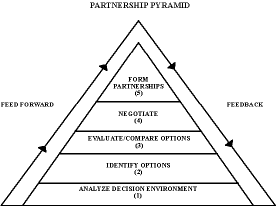Â
|
Outsourcing: Some companies can do it all. Others find it more profitable not to. More companies are outsourcing in an attempt to increase their competitiveness and focus on their core competencies. The challenge becomes determining which products, activities, and functions should be outsourced and which vendors should be used. |
|
Vendor selection problems are often driven by multiple criterion, and the pharmaceutical firm determined that there were three primary factors in evaluating and selecting the vendors -- price, delivery performance, and quality. The next step is to identify options. In order to do this, the problem was formulated as a multiobjective programming model to determine vendor selection and order quantity allocation.
The price objective was to minimize the cost of the required material, the delivery objective was to minimize the amount of material delivered late, and the quality objective was to minimize the amount of rejected material. The constraints ensured that demand was met, capacities were not exceeded, and minimum order quantities were met. A final constraint was added to reflect the firm's policy to select five out of the six potential vendors.
With a single criterion model, typically only one solution is found -- the one that maximizes or minimizes the single objective function. With multiple criterion, as with the pharmaceutical firm's decision, there will generally be tradeoffs among the different objectives (i.e., one objective can be improved by sacrificing one or more of the other objectives). To evaluate these tradeoffs, the problem was solved multiple times with What'sBest! while varying the weights put on price, delivery performance and quality resulting in several efficient solutions. An efficient solution is one in which no other feasible solution exists that improves upon one objective without degrading one or more other objectives.
On why they used What'sBest!, Dr. Weber, one of the paper's authors, stated, "The ease-of-use was a big factor. We build a lot of prototype models, and What'sBest! allows us to do it quickly and easily on our own -- without calling in programmers."
After evaluating the solutions, the next step is to negotiate with the potential vendors. During the negotiation, the outsourcing firm can work with the vendors to investigate ways that they can vary their performance to better fit the firm's preferences. The final stage is to form partnerships to implement the decision.
For more information on What'sBest!, please see the product pages. You can also download a demo version from our download page or order a full blown version directly from our order page.

